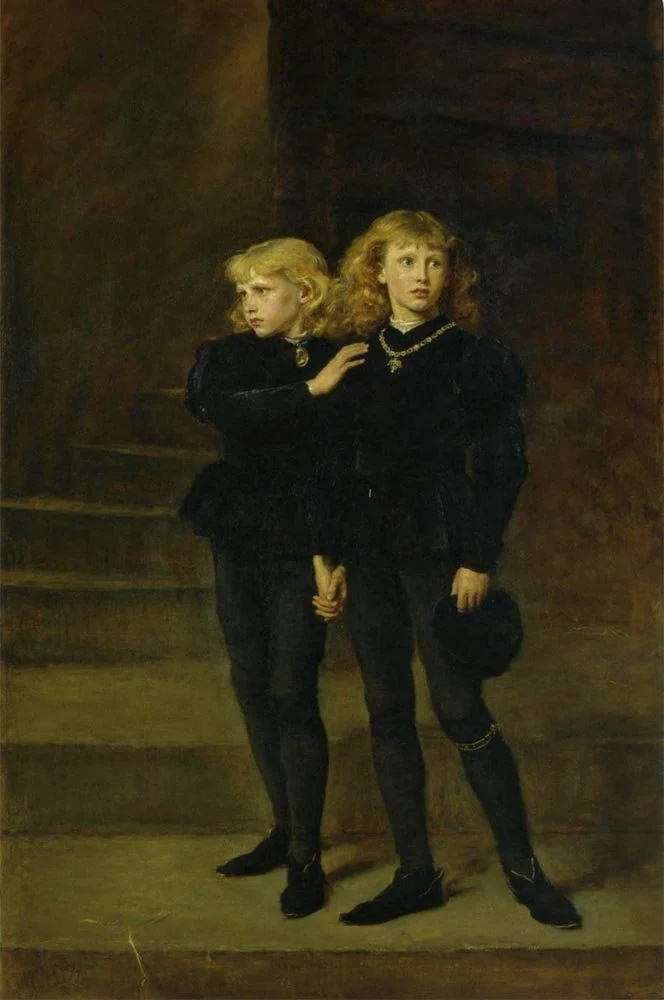King Edward V the Lost King
King Edward V was the son of Edward IV and Elizabeth Woodville. At just 12 years old, Edward V accedes to the throne of England, following the death of his father. His uncle, Richard Duke of Gloucester, is declared Protector of England, until Edward comes of age. But tragedy dominates his short life and reign, his legitimacy is questioned, and his uncle seizes the throne. Within a few short months, Edward and his younger brother Richard, disappear at the Tower of London, leading to the long standing, medieval mystery ever since.
| Born | 2 November 1470, Westminster |
| Parents | Edward IV and Elizabeth Woodville |
| Married | No |
| Children | None |
| Died | Unknown, presumed September 1483, Tower of London (12) |
| Reign | 1483 (2-4 months) |
| Crowned | No |
| Predecessor | Edward IV (father) |
| Successor | Richard III (uncle) |
| House | York |
Life Events of King Edward V
1470
On 2 November, Edward V is born to Edward IV and Elizabeth Woodville, in the Abbot of Westminster’s house. Elizabeth was taking sanctuary there during the Wars of the Roses.
1471
In June, Edward V is appointed Prince of Wales.
1473
Anthony Woodville, 2nd Earl Rivers, is appointed head of the Prince of Wales’ household by King Edward IV. He is to supervise his nephew, Edward V at Ludlow Castle.
1480
Edward V is betrothed to 4 year old, Anne of Brittany, to marry when they come of age. Anne is the daughter of Francis II, Duke of Brittany, an ally to Edward IV.
1483
On 9 April, King Edward V, accedes to the throne of England, following the death of his father, Edward IV. He hears the news 5 days later in Ludlow, on 14 April.
1483
Edward’s uncle, Richard Duke of Gloucester, brother to Edward IV, is named Protector of England.
1483
On 24 April, 12 year old King Edward V sets off for London from his childhood home, Ludlow Castle.
1483
On 29 April, Richard, Protector of England, has Edward V’s uncle, Anthony Woodville Earl Rivers, arrested along with Edward V’s half-brother, Richard Grey and his chamberlain, Thomas Vaughan.
1483
Edward V is offered lodging with the Bishop of London, before settling into the royal apartments in the Tower of London on 19 May. He is joined by his younger brother, Richard of Shrewsbury, Duke of York on 16 June.
1483
Edward V’s coronation, due on the 22 June, is repeatedly postponed by Richard Duke of Gloucester, Protector of England. A sermon by Ralph Shaa, claims that Edward IV was already married to Eleanor Talbot (Butler) at the time of his marriage to Elizabeth Woodville. Therefore, the second marriage is invalid. King Edward V’s legitimacy is now in question.
1483
On 25 June, an assembly of Lords and Commons declare Richard Duke of Gloucester, king of England. Richard becomes king the next day, on 26 June.
1483
Despite Edward V’s protests, the now King Richard III, orders the execution of Earl Rivers, Richard Grey and Thomas Vaughan, after a brief imprisonment at Pontefract Castle.
1483
The young princes, Edward V and Richard of Shrewsbury, are taken into the inner apartments of the Tower of London. The last sighting of them is in September. They are never seen again.
Interesting Facts About King Edward V
Upbringing
Edward V had a very scheduled upbringing, on the orders of his father, King Edward IV. Under the supervision of his uncle, Anthony Woodville, Earl Rivers, he was to follow precise conditions each day. He was to “arise every morning at a convenient hour, according to his age”, followed by uninterrupted matins and mass.Education consists of “virtuous learning” and reading of “noble stories of virtue, honour, cunning, wisdom and worship but nothing to stir him to vice”. No one in the household was to be a habitual “swearer, brawler, backbiter, common hazarder, adulterer or user of ribaldry (vulgar jokes).
Afternoon is to be filled with sporting activities, followed by supper from 4 o’clock, with curtains drawn at 8 o’clock. Edward’s attendants should “enforce themselves to make him merry and joyous towards his bed”, and watch over him while he slept.
Disappearance
The young princes were last seen in the grounds of the Tower of London in September 1483. Their disappearance is still a mystery. King Richard III and King Henry VII had the most to gain from their disappearance, but nothing has ever been proven.In 1674, the skeletons of two young boys were discovered during repair work at the Tower of London, ten feet below the foot of a staircase. They were reburied at Westminster Abbey, by Charles II.
There is no evidence that these remains are the young princes, despite an effort in 1993 which proved they were the remains of young males, who were about the right age.
Recently, there have been rumours that King Charles III is keen to allow the bodies to be exhumed once more. Modern forensic tests could extract vital information from the bones, but it is uncertain what that could prove. It is unlikely that it will help solve the mystery of who killed them, but may shed some more light onto this long standing, medieval mystery.
Battles Fought During King Edward V’s Life
King Edward V was only twelve when he disappeared, so he did not fight in any battles himself.
Battle of Barnet
On 14 April 1471, Edward V’s father, King Edward IV leads his Yorkist forces against Richard, Earl of Warwick and the Lancastrians. The Yorkists seized an advantage, while the Lancastrians were in disarray, and defeated them. Warwick is executed after the battle.Battle of Tewkesbury
On 4 May 1471, the Yorkists, led by King Edward IV, win a decisive victory against the Lancastrians. Edward, Prince of Wales is killed in battle and Edmund Beaufort, Duke of Somerset is executed afterwards.
FAQs About the King
What happened to King Edward V?
Edward V's reign was never officially established because he and his younger brother, Richard, Duke of York, disappeared in 1483 under mysterious circumstances. They were last seen in the Tower of London, and their fate remains unknown.What is the significance of the ‘Princes in the Tower’?
The ‘Princes in the Tower’ refers to Edward V and his younger brother, Richard, Duke of York. Their disappearance is one of the most enduring mysteries in English history and has fueled speculation and conspiracy theories for centuries.Who is believed to be responsible for the disappearance of the ‘Princes in the Tower’?
The most commonly suggested suspect in the disappearance of the ‘Princes in the Tower’ is their uncle, Richard, Duke of Gloucester, who later became Richard III. However, the exact circumstances and the true culprits remain uncertain.What impact did the disappearance of Edward V have on English history?
The disappearance of Edward V and his brother Richard led to political turmoil and instability. It played a significant role in the Wars of the Roses and the subsequent rise of the Tudor dynasty, with Henry VII becoming the first Tudor monarch.Has any evidence been found regarding the fate of the ‘Princes in the Tower’?
Despite ongoing historical investigations, no definitive evidence has emerged regarding the fate of the ‘Princes in the Tower’. Various theories suggest different possibilities, including murder or abduction, but none have been conclusively proven. There are the bones of two young children reinterred in Westminster Abbey, which were found under a staircase in the Tower of London around 350 years ago (1674). These may be able to provide further clues, perhaps confirming they belong to the lost Princes. However, the current monarch needs to grant permission for any investigation into these bones.
The Young Princes at the Tower of London
Princes Edward V and Richard of Shrewsbury, Duke of York await uncertain fate




